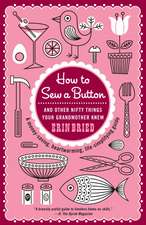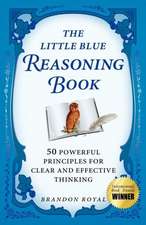How to Build a Fire: And Other Handy Things Your Grandfather Knew
Autor Erin Brieden Limba Engleză Paperback – 30 noi 2010
As members of the Greatest Generation, our grandfathers were not only defined by the Depression but also by their heroic service to the country in World War II. Courageous, responsible, and involved, they understand sacrifice, hard work, and how to do whatever is necessary to take care of their loved ones. They also know how to have a rollicking good time.
Sensible, fun, and inspiring, How to Build a Fire offers a rare glimpse into the hearts and minds of grandfathers near and far by sharing their practical skills and sweet stories on how to be stronger, smarter, richer, and happier. Inside are more than one hundred essential step-by-step tips for fixing, leading, prospering, playing, and hosting, including how to
• buck up and be brave in the face of adversity
• play hard and break in a baseball mitt
• bait a hook and catch a big fish
• look dapper and tie a perfect tie
• get a raise and earn more
• write a love letter and kindle romance
• change a flat tire and save the day
• stand up and give a sparkling toast
• play the harmonica and make your own music
Loaded with charming illustrations, good humor, and warm nostalgia, How to Build a Fire is the perfect handbook for guys or gals of any age. The first of its kind, this collection of our grandfathers’ hard-earned wisdom will help you build confidence and get back to what’s really important in life.
Preț: 127.10 lei
Nou
Puncte Express: 191
Preț estimativ în valută:
24.32€ • 25.44$ • 20.20£
24.32€ • 25.44$ • 20.20£
Carte disponibilă
Livrare economică 12-26 martie
Preluare comenzi: 021 569.72.76
Specificații
ISBN-13: 9780345525093
ISBN-10: 0345525094
Pagini: 266
Ilustrații: 37 B/W ILLUS. THROUGHOUT
Dimensiuni: 134 x 204 x 17 mm
Greutate: 0.24 kg
Editura: BALLANTINE BOOKS
ISBN-10: 0345525094
Pagini: 266
Ilustrații: 37 B/W ILLUS. THROUGHOUT
Dimensiuni: 134 x 204 x 17 mm
Greutate: 0.24 kg
Editura: BALLANTINE BOOKS
Recenzii
“Erin Bried can build a fire, thanks to grandpa.”—USA Today
“A step-by-step guide to (almost) everything the hard-working, self-sufficient Greatest Generation learned about life and living.”—Chicago Tribune
“Don’t pass up How to Build a Fire…it’s [full of] knowledge our grandfathers seem to possess in abundance ߝ life skills that made them such stand-up guys.”—The Houston Chronicle
“How To Build a Fire is fascinating, humbling and humorous.”—The Chicago Sun-Times
“Erin Bried can help you nail certain tasks.”—The New York Daily News
“How to Build a Fire is a succinct life-skills book filled with humor and wisdom…useful for both men and women….It’s a quick, useful guide with a touch of nostalgia.”—Library Journal
“How to Build a Fire takes readers back to basics by championing more than 100 practical life skills. All of them are guaranteed for life, but are especially valuable during an economic recession.”—Book Page
“How to Build a Fire offers sound advice on manual jobs and also gives lessons on more subtle skills.”—Boston Globe
“How to Build a Fire makes a lovely stocking stuffer by a roaring fire.”—SELF magazine
“Our elders could still teach us a lot—and you’ll find it all in How to Build a Fire by Erin Bried. It demystifies stuff like making ice cream (yay!) and playing dominoes. Your kids will think you’re the coolest.”—Parenting magazine
“Although her book touches on the sacrifices of the “Greatest Generation,” Bried’s How to Build a Fire is a companion piece to Tom Brokaw’s 1998 book. The former newscaster’s book lauds the efforts of the people who grew up during the Depression and saved the world by winning World War II. Bried’s book acknowledges those efforts ߝ eight of the 10 grandfathers served in the war ߝ but she lets them teach lessons big and small.”—Stockton Record
“How to Build a Fire is a practical guide to all those things you always meant to learn, from breaking in a baseball mitt to writing a love letter — and being a role model for your kids.”—St Petersburg Times
“How many times have you wished your grandfather were still around to give you some priceless advice?”—Tulsa World
“…Fun to read. More importantly, it’s the perfect gift, birthday or otherwise, for grandchildren of any age, or even their parents! After all, you can only learn just so much on the Internet.”—Monterey County Herald
“If How to Build a Fire is anything like How to Sew a Button, then it will be a great gift for any young adult in your life, male or female. Because honestly, we should all know how to sew on a button and build a fire. Just in case…”—Frederick News Post
“A step-by-step guide to (almost) everything the hard-working, self-sufficient Greatest Generation learned about life and living.”—Chicago Tribune
“Don’t pass up How to Build a Fire…it’s [full of] knowledge our grandfathers seem to possess in abundance ߝ life skills that made them such stand-up guys.”—The Houston Chronicle
“How To Build a Fire is fascinating, humbling and humorous.”—The Chicago Sun-Times
“Erin Bried can help you nail certain tasks.”—The New York Daily News
“How to Build a Fire is a succinct life-skills book filled with humor and wisdom…useful for both men and women….It’s a quick, useful guide with a touch of nostalgia.”—Library Journal
“How to Build a Fire takes readers back to basics by championing more than 100 practical life skills. All of them are guaranteed for life, but are especially valuable during an economic recession.”—Book Page
“How to Build a Fire offers sound advice on manual jobs and also gives lessons on more subtle skills.”—Boston Globe
“How to Build a Fire makes a lovely stocking stuffer by a roaring fire.”—SELF magazine
“Our elders could still teach us a lot—and you’ll find it all in How to Build a Fire by Erin Bried. It demystifies stuff like making ice cream (yay!) and playing dominoes. Your kids will think you’re the coolest.”—Parenting magazine
“Although her book touches on the sacrifices of the “Greatest Generation,” Bried’s How to Build a Fire is a companion piece to Tom Brokaw’s 1998 book. The former newscaster’s book lauds the efforts of the people who grew up during the Depression and saved the world by winning World War II. Bried’s book acknowledges those efforts ߝ eight of the 10 grandfathers served in the war ߝ but she lets them teach lessons big and small.”—Stockton Record
“How to Build a Fire is a practical guide to all those things you always meant to learn, from breaking in a baseball mitt to writing a love letter — and being a role model for your kids.”—St Petersburg Times
“How many times have you wished your grandfather were still around to give you some priceless advice?”—Tulsa World
“…Fun to read. More importantly, it’s the perfect gift, birthday or otherwise, for grandchildren of any age, or even their parents! After all, you can only learn just so much on the Internet.”—Monterey County Herald
“If How to Build a Fire is anything like How to Sew a Button, then it will be a great gift for any young adult in your life, male or female. Because honestly, we should all know how to sew on a button and build a fire. Just in case…”—Frederick News Post
Extras
1
Pioneering
Begin by knowing your way around your kingdom. That way, you'll always be warm, safe, happy, and well fed wherever you go.
Grow Up
"Talk to plants, and they will grow. Life without love, for all living things, is nothing. If you give love to something, it will reciprocate. That's how we are as humans, too."
-Angel Rodriguez
How to Plant a Tree
Step 1: Choose the right tree. Consider not only its size, speed of growth, shape, and looks, but also its hardiness. It should be native to your area and strong enough to weather the hottest and coldest temperatures, and all the sunshine and rain you may or may not get. Other things to think about: Will your tree lose its leaves every year (and do you really want to rake them)? Does it bear fruit (and if so, will you eat it or curse it when it's smushed on the bottom of your shoe)?
Step 2: Find a good spot. Look up, look down, look all around and make sure your tree will have plenty of space to thrive. Your tree may look small now, but it won't be for very long, and if you plant a soon-to- be-big sucker right next to your house or directly under utility lines, you'll be paying for that bad decision for years to come. Also, a no-brainer: Before digging any holes, call your local utility company to make sure you're clear of any underground cables.
Step 3: Dig a hole. A well-planted tree will grow faster and live longer than a poorly planted tree, so take care to do it right. Using a shovel, dig a big ol' bowl-shaped hole as deep as the tree's roots (or root-ball) and at least twice as wide. The hole will most certainly look bigger than you think it needs to be, but the roots need that extra room to grow. Don't slack on the digging.
Step 4: Measure up. Place your tree in the hole and see if it's deep enough. If it's just right, proceed to step 5. If it's too deep, put some soil back. If it's too shallow, go have a lemonade. Then come back and keep digging.
Step 5: Position your tree. It should stand upright in the center of the hole. If your tree comes in a container, tap the pot to gently remove it, being careful not to rip the trunk from the roots. If your tree comes with its roots wrapped in burlap, plunk the whole thing in the pit and carefully remove the burlap, along with any twine, wire, nails, or staples.
Step 6: Fill the hole. Replace the soil you removed, packing it down firmly around the roots. You'll want your tree pit to catch water, so make sure your tree grows from the pit's deepest point. Then look for a little bulge at the base of your tree's trunk. It's called the root collar, and you want your soil to snuggle its bottom only. If you can't see your tree's collar, it may be planted too deep.
Step 7: Add water. Give the ground a good soak.
Step 8: Spread mulch (wood chips or bark) around your tree a couple of inches deep. It'll help keep the soil warm and moist, prevent weeds and erosion, and just make the whole thing look nice.
Step 9: Feel proud. Not only do trees help beautify the world, but they also help you save on energy costs, improve your water and air quality, give a home to songbirds, boost your property value, and fight global warming. Take good care of it by watering it once a week and pruning only dead or broken branches.
More Handy Tips:
To find the best trees for your area, enter your zip code at ArborDay.org and get all the information you've ever dreamed of. Better yet, join the Arbor Day Foundation for ten dollars, and you'll receive ten free trees of your choice. Seriously.
If you're planting a sapling with naked roots, remove any packaging and soak the roots in a bucket of water for up to six hours before planting.
If you're planting a tree that came in a pot and the roots look tangled once they're free, use a utility knife and make an X on the bottom of the root-ball and a vertical line down each side.
Aim True
"By the time I was six, I was splitting wood. Make sure you've got it lined up right and then go from there. It's not about muscle. The ax will do the work for you, but you can help it a little bit. If you're lucky, you'll hit it and have two pieces of wood. Usually, it takes a few blows. And don't cut your feet!"
-Philip Spooner
How to Split Firewood
Step 1: Dress appropriately. Wear safety goggles, leather work gloves, steel-toed boots, and a plaid flannel shirt, if you've got one. The first three items will help protect you from harm, while the last one will make you look butch. You'll also need a maul, which is basically a fatter version of an ax built specifically for splitting wood vertically, as opposed to chopping across it. (Axes will work, too, but because they're slimmer, they tend to get stuck in the wood more often, and that's just frustrating.)
Step 2: Set a twelve- to eighteen-inch log on end on a raised, flat wooden surface about fourteen inches tall. The perfect chopping block: a sawed-off tree stump. Your second-best option: on the soft ground. You may have to wrest your maul from the depths of the dirt sometimes, but that'll only help you build stronger muscles. Never ever split wood on pavement, or you and anybody in your vicinity will get hurt. Flying shards of steel? Not fun.
Step 3: Get in position, and eyeball where you'd like to split the wood. Cracks are nature's way of helping you along, so take advantage of them. Once you've focused on your target, place the sharp edge of your maul on it and, with your arms fully extended, grip the end of the handle with both hands. Step back a few inches so you're slightly reaching, and plant your feet shoulder-width apart.
Step 4: Prepare to strike. Pick up your maul and hold it parallel to the ground, across the front of your body, blade facing away from you. Place your weak hand at the base of the handle, palm facing down, and your dominant hand closer to the head, palm facing up. Grunt for good measure.
Step 5: Swing deep. Slightly bend your knees, and then raise your maul overhead with your arms extended, allowing your dominant hand to slide to the base of the handle. Keeping your eye on your target, swing your maul in a downward motion to meet the wood. Find the grace in the movement. Every woodsman knows that technique (and gravity) counts more than brute strength.
Step 6: Repeat as necessary. Maybe it'll take one good crack, maybe more. Just keep hitting your log in the same place until it splits. Then keep going until you have your desired amount of splits. Save the little pieces, too. They make great kindling.
Step 7: Stack 'em up and let 'em dry. If it's new wood, it'll be ready to burn in about nine months. If it's already seasoned, it's ready to burn now.
More Handy Tips
Knotty, gnarly, or curvy wood can be tough to split. Save those pieces for last or, better yet, just use them for decoration.
To gain more momentum in your swing, rise up on your toes before dropping your maul.
If your maul does get stuck, keep a few steel wedges nearby and tap them into the wood with a little sledgehammer. That'll usually be enough to split the log into pieces and free your tool.
Always remember, the best cure for a hot head and a cold house: splitting wood. Do it as often as necessary.
Stay Warm
"We used to go camping when I was a boy. We'd put a lean-to in our packs and head out and live off the country for three or four days. If you spend a night in the woods and you don't know how to build a fire, you're going to be cold."
-Bill Holloman
How to Build a Fire
Step 1: Find a good spot. Look for a clearing, one that's far away from houses, trees, roots, and overhanging branches and also sheltered from the wind. Then clear a circle about three feet across, brush or dig out the center so it's slightly concave, and place big, dry rocks around the edge.
Step 2: Gather your supplies: matches, tinder (twigs, dried grasses and leaves, newspaper, and so on), kindling (sticks smaller than your wrist), two or three dry, split, seasoned logs about twelve to eighteen inches long, and a pail of water (or sand or dirt) for safety.
Step 3: Build a tepee-shaped blaze. Just toss your tinder into the center, leaving space for oxygen to circulate around it. Stand your smallest pieces of kindling on end to form a pyramid over your tinder. Repeat with three or four larger pieces of kindling. Then, without knocking the whole thing over, hold your breath and very gently lean a couple of logs on top. Exhale.
Step 4: Strike a match, light your tinder, and watch it all go up in flames, just as you'd hoped. Once the fire really gets roaring, the logs will topple over the hot coals to keep burning. Add more logs as needed, being careful you don't smother the flames.
Step 5: Get out your s'more fixin's and let the ghost stories begin. Did you hear the one about the guy with a hook for a hand? What about the girl with the ribbon around her neck? Come to think of it, who is that standing behind that tree?
More Handy Tips
If there's not a lot of tinder around, you might have to get creative. Try dried pine needles, pieces of papery birch bark, a fallen bird's nest (pulled apart), or even the fluff from a cattail (ahem, the kind that grows in wetlands, not the kind that is connected to your neighbor's kitty). Pine pitch (or sap) will always light, even on wet days. So will a cotton ball swabbed with Vaseline.
To identify good fire logs, knock two together. If you hear a clunk, they're ready to burn. If you hear a thud, they're probably still too wet to do anything but smoke you out.
Never build your fire on top of rocks, and never toss rocks into it, either. Hot rocks can explode, possibly causing harm to anyone nearby.
Never leave an unattended fire burning. Always, always put it out, using water, sand, or dirt.
To prevent your matches from getting wet, dip their tips in wax and store them in an empty film canister.
No matches? Build a fire plow. Find a piece of soft wood about a foot or two long and a very hard, pointy stick, about a foot long. Rub the point of your stick along the grain of the soft wood until you form a groove. When you see saw dust collecting, rub faster; you'll eventually get a tiny burning ember. Touch it to your tinder, and ignite your blaze. It may not be the quickest way to start a fire, but it sure beats freezing your you-know-what off.
Stay Afloat
"We had tin boat races in the basin, and they were thrilling. You'd fold up a piece of corrugated iron, about three feet wide and eight feet long, and fasten it together on the ends with screws and tar. I had one that I called the Orchid, which I painted lavender. I was doing real well in the race, but then I got too exuberant and I capsized it and it sank. Of course, I swam down and brought it back up again!"
-Buck Buchanan
How to Paddle a Canoe
Step 1: Climb aboard. This is the hardest thing you'll do all day, but if you can get in a canoe without tipping it, then you'll be golden on the pond. Just stay low in a crouched position, step as close to the centerline as possible, and slide both hands along the sides to steady yourself as you walk toward your seat. If you're alone, sit in the back of the boat.
Step 2: Grab your paddle. If you're right-handed, grip the paddle with your left hand on top of the handle and your right hand on the shaft, closer to the blade. To check your grip, hold the paddle in front of you, parallel to the water. Your arms should be just slightly wider than shoulder-width apart.
Step 3: Use the simple J-stroke, so you don't have to be bothered switching sides with every paddle. While keeping your chin up and back straight, reach high with your paddle and then dive it into the water just ahead of your knees. The blade should be perpendicular to the boat and fully submerged. Then draw your paddle alongside the boat, and when your left hand is extended across your body and your right hand is even with your hips, turn the blade parallel to the boat and use it as a rudder; push it gently away from you to scoop out a gentle J-shaped hook. (On the right side of the boat, it's actually a backward J.) Repeat the stroke from the start.
Step 4: Check your course. If you're paddling properly, you should be going in a straight line.
More Handy Tips
Always wear a life preserver and sunscreen when boating. Both can save your life.
When your arm gets tired, switch sides (and grips), and use the J- stroke on the other side. Remember, your J should always hook away from the boat.
Keep your boat straight in rapids and waves. If you approach either sideways, you'll swamp your boat, and it'll sink.
If you plan on paddling for a long time, bring water with you. A snack couldn't hurt, either. And toss a change of clothes in a dry bag, in case you happen to get wet.
Get Hooked
"When I was two and a half years old, my grandfather got an alder limb, a piece of twine, and a fishhook. He put an angleworm on the hook and set me loose at the creek behind our house. I caught a trout about four inches long! I came back and showed my mother. She didn't know I was fishin'! She looked at my grandfather and said, "You left him all alone?" My grandfather said, "He's old enough to go fishin'. See? He caught one!"?"
-Philip Spooner
How to Catch a Freshwater Fish
Step 1: Gather your equipment: a spinning rod and reel (with hook, line, and sinker attached); some bait; an ice-filled cooler for your catch; a sandwich, drink, and chips (for you, not the fish); and your fishing license. (Get one at your local bait shop before you go, or you may be hit with a very large fine. What's worse, you won't get to keep your catch or possibly even your equipment.)
Pioneering
Begin by knowing your way around your kingdom. That way, you'll always be warm, safe, happy, and well fed wherever you go.
Grow Up
"Talk to plants, and they will grow. Life without love, for all living things, is nothing. If you give love to something, it will reciprocate. That's how we are as humans, too."
-Angel Rodriguez
How to Plant a Tree
Step 1: Choose the right tree. Consider not only its size, speed of growth, shape, and looks, but also its hardiness. It should be native to your area and strong enough to weather the hottest and coldest temperatures, and all the sunshine and rain you may or may not get. Other things to think about: Will your tree lose its leaves every year (and do you really want to rake them)? Does it bear fruit (and if so, will you eat it or curse it when it's smushed on the bottom of your shoe)?
Step 2: Find a good spot. Look up, look down, look all around and make sure your tree will have plenty of space to thrive. Your tree may look small now, but it won't be for very long, and if you plant a soon-to- be-big sucker right next to your house or directly under utility lines, you'll be paying for that bad decision for years to come. Also, a no-brainer: Before digging any holes, call your local utility company to make sure you're clear of any underground cables.
Step 3: Dig a hole. A well-planted tree will grow faster and live longer than a poorly planted tree, so take care to do it right. Using a shovel, dig a big ol' bowl-shaped hole as deep as the tree's roots (or root-ball) and at least twice as wide. The hole will most certainly look bigger than you think it needs to be, but the roots need that extra room to grow. Don't slack on the digging.
Step 4: Measure up. Place your tree in the hole and see if it's deep enough. If it's just right, proceed to step 5. If it's too deep, put some soil back. If it's too shallow, go have a lemonade. Then come back and keep digging.
Step 5: Position your tree. It should stand upright in the center of the hole. If your tree comes in a container, tap the pot to gently remove it, being careful not to rip the trunk from the roots. If your tree comes with its roots wrapped in burlap, plunk the whole thing in the pit and carefully remove the burlap, along with any twine, wire, nails, or staples.
Step 6: Fill the hole. Replace the soil you removed, packing it down firmly around the roots. You'll want your tree pit to catch water, so make sure your tree grows from the pit's deepest point. Then look for a little bulge at the base of your tree's trunk. It's called the root collar, and you want your soil to snuggle its bottom only. If you can't see your tree's collar, it may be planted too deep.
Step 7: Add water. Give the ground a good soak.
Step 8: Spread mulch (wood chips or bark) around your tree a couple of inches deep. It'll help keep the soil warm and moist, prevent weeds and erosion, and just make the whole thing look nice.
Step 9: Feel proud. Not only do trees help beautify the world, but they also help you save on energy costs, improve your water and air quality, give a home to songbirds, boost your property value, and fight global warming. Take good care of it by watering it once a week and pruning only dead or broken branches.
More Handy Tips:
To find the best trees for your area, enter your zip code at ArborDay.org and get all the information you've ever dreamed of. Better yet, join the Arbor Day Foundation for ten dollars, and you'll receive ten free trees of your choice. Seriously.
If you're planting a sapling with naked roots, remove any packaging and soak the roots in a bucket of water for up to six hours before planting.
If you're planting a tree that came in a pot and the roots look tangled once they're free, use a utility knife and make an X on the bottom of the root-ball and a vertical line down each side.
Aim True
"By the time I was six, I was splitting wood. Make sure you've got it lined up right and then go from there. It's not about muscle. The ax will do the work for you, but you can help it a little bit. If you're lucky, you'll hit it and have two pieces of wood. Usually, it takes a few blows. And don't cut your feet!"
-Philip Spooner
How to Split Firewood
Step 1: Dress appropriately. Wear safety goggles, leather work gloves, steel-toed boots, and a plaid flannel shirt, if you've got one. The first three items will help protect you from harm, while the last one will make you look butch. You'll also need a maul, which is basically a fatter version of an ax built specifically for splitting wood vertically, as opposed to chopping across it. (Axes will work, too, but because they're slimmer, they tend to get stuck in the wood more often, and that's just frustrating.)
Step 2: Set a twelve- to eighteen-inch log on end on a raised, flat wooden surface about fourteen inches tall. The perfect chopping block: a sawed-off tree stump. Your second-best option: on the soft ground. You may have to wrest your maul from the depths of the dirt sometimes, but that'll only help you build stronger muscles. Never ever split wood on pavement, or you and anybody in your vicinity will get hurt. Flying shards of steel? Not fun.
Step 3: Get in position, and eyeball where you'd like to split the wood. Cracks are nature's way of helping you along, so take advantage of them. Once you've focused on your target, place the sharp edge of your maul on it and, with your arms fully extended, grip the end of the handle with both hands. Step back a few inches so you're slightly reaching, and plant your feet shoulder-width apart.
Step 4: Prepare to strike. Pick up your maul and hold it parallel to the ground, across the front of your body, blade facing away from you. Place your weak hand at the base of the handle, palm facing down, and your dominant hand closer to the head, palm facing up. Grunt for good measure.
Step 5: Swing deep. Slightly bend your knees, and then raise your maul overhead with your arms extended, allowing your dominant hand to slide to the base of the handle. Keeping your eye on your target, swing your maul in a downward motion to meet the wood. Find the grace in the movement. Every woodsman knows that technique (and gravity) counts more than brute strength.
Step 6: Repeat as necessary. Maybe it'll take one good crack, maybe more. Just keep hitting your log in the same place until it splits. Then keep going until you have your desired amount of splits. Save the little pieces, too. They make great kindling.
Step 7: Stack 'em up and let 'em dry. If it's new wood, it'll be ready to burn in about nine months. If it's already seasoned, it's ready to burn now.
More Handy Tips
Knotty, gnarly, or curvy wood can be tough to split. Save those pieces for last or, better yet, just use them for decoration.
To gain more momentum in your swing, rise up on your toes before dropping your maul.
If your maul does get stuck, keep a few steel wedges nearby and tap them into the wood with a little sledgehammer. That'll usually be enough to split the log into pieces and free your tool.
Always remember, the best cure for a hot head and a cold house: splitting wood. Do it as often as necessary.
Stay Warm
"We used to go camping when I was a boy. We'd put a lean-to in our packs and head out and live off the country for three or four days. If you spend a night in the woods and you don't know how to build a fire, you're going to be cold."
-Bill Holloman
How to Build a Fire
Step 1: Find a good spot. Look for a clearing, one that's far away from houses, trees, roots, and overhanging branches and also sheltered from the wind. Then clear a circle about three feet across, brush or dig out the center so it's slightly concave, and place big, dry rocks around the edge.
Step 2: Gather your supplies: matches, tinder (twigs, dried grasses and leaves, newspaper, and so on), kindling (sticks smaller than your wrist), two or three dry, split, seasoned logs about twelve to eighteen inches long, and a pail of water (or sand or dirt) for safety.
Step 3: Build a tepee-shaped blaze. Just toss your tinder into the center, leaving space for oxygen to circulate around it. Stand your smallest pieces of kindling on end to form a pyramid over your tinder. Repeat with three or four larger pieces of kindling. Then, without knocking the whole thing over, hold your breath and very gently lean a couple of logs on top. Exhale.
Step 4: Strike a match, light your tinder, and watch it all go up in flames, just as you'd hoped. Once the fire really gets roaring, the logs will topple over the hot coals to keep burning. Add more logs as needed, being careful you don't smother the flames.
Step 5: Get out your s'more fixin's and let the ghost stories begin. Did you hear the one about the guy with a hook for a hand? What about the girl with the ribbon around her neck? Come to think of it, who is that standing behind that tree?
More Handy Tips
If there's not a lot of tinder around, you might have to get creative. Try dried pine needles, pieces of papery birch bark, a fallen bird's nest (pulled apart), or even the fluff from a cattail (ahem, the kind that grows in wetlands, not the kind that is connected to your neighbor's kitty). Pine pitch (or sap) will always light, even on wet days. So will a cotton ball swabbed with Vaseline.
To identify good fire logs, knock two together. If you hear a clunk, they're ready to burn. If you hear a thud, they're probably still too wet to do anything but smoke you out.
Never build your fire on top of rocks, and never toss rocks into it, either. Hot rocks can explode, possibly causing harm to anyone nearby.
Never leave an unattended fire burning. Always, always put it out, using water, sand, or dirt.
To prevent your matches from getting wet, dip their tips in wax and store them in an empty film canister.
No matches? Build a fire plow. Find a piece of soft wood about a foot or two long and a very hard, pointy stick, about a foot long. Rub the point of your stick along the grain of the soft wood until you form a groove. When you see saw dust collecting, rub faster; you'll eventually get a tiny burning ember. Touch it to your tinder, and ignite your blaze. It may not be the quickest way to start a fire, but it sure beats freezing your you-know-what off.
Stay Afloat
"We had tin boat races in the basin, and they were thrilling. You'd fold up a piece of corrugated iron, about three feet wide and eight feet long, and fasten it together on the ends with screws and tar. I had one that I called the Orchid, which I painted lavender. I was doing real well in the race, but then I got too exuberant and I capsized it and it sank. Of course, I swam down and brought it back up again!"
-Buck Buchanan
How to Paddle a Canoe
Step 1: Climb aboard. This is the hardest thing you'll do all day, but if you can get in a canoe without tipping it, then you'll be golden on the pond. Just stay low in a crouched position, step as close to the centerline as possible, and slide both hands along the sides to steady yourself as you walk toward your seat. If you're alone, sit in the back of the boat.
Step 2: Grab your paddle. If you're right-handed, grip the paddle with your left hand on top of the handle and your right hand on the shaft, closer to the blade. To check your grip, hold the paddle in front of you, parallel to the water. Your arms should be just slightly wider than shoulder-width apart.
Step 3: Use the simple J-stroke, so you don't have to be bothered switching sides with every paddle. While keeping your chin up and back straight, reach high with your paddle and then dive it into the water just ahead of your knees. The blade should be perpendicular to the boat and fully submerged. Then draw your paddle alongside the boat, and when your left hand is extended across your body and your right hand is even with your hips, turn the blade parallel to the boat and use it as a rudder; push it gently away from you to scoop out a gentle J-shaped hook. (On the right side of the boat, it's actually a backward J.) Repeat the stroke from the start.
Step 4: Check your course. If you're paddling properly, you should be going in a straight line.
More Handy Tips
Always wear a life preserver and sunscreen when boating. Both can save your life.
When your arm gets tired, switch sides (and grips), and use the J- stroke on the other side. Remember, your J should always hook away from the boat.
Keep your boat straight in rapids and waves. If you approach either sideways, you'll swamp your boat, and it'll sink.
If you plan on paddling for a long time, bring water with you. A snack couldn't hurt, either. And toss a change of clothes in a dry bag, in case you happen to get wet.
Get Hooked
"When I was two and a half years old, my grandfather got an alder limb, a piece of twine, and a fishhook. He put an angleworm on the hook and set me loose at the creek behind our house. I caught a trout about four inches long! I came back and showed my mother. She didn't know I was fishin'! She looked at my grandfather and said, "You left him all alone?" My grandfather said, "He's old enough to go fishin'. See? He caught one!"?"
-Philip Spooner
How to Catch a Freshwater Fish
Step 1: Gather your equipment: a spinning rod and reel (with hook, line, and sinker attached); some bait; an ice-filled cooler for your catch; a sandwich, drink, and chips (for you, not the fish); and your fishing license. (Get one at your local bait shop before you go, or you may be hit with a very large fine. What's worse, you won't get to keep your catch or possibly even your equipment.)
Descriere
From baiting a fish hook to tying a necktie, "How to Build a Fire" offers a rare glimpse into the hearts and minds of grandfathers by sharing their practical skills and sweet stories on how to be stronger, smarter, richer, and happier.
Notă biografică
Erin Bried


















